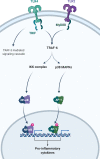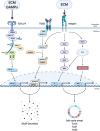Regulation of cellular senescence by extracellular matrix during chronic fibrotic diseases
- PMID: 33084883
- PMCID: PMC7578566
- DOI: 10.1042/CS20190893
Regulation of cellular senescence by extracellular matrix during chronic fibrotic diseases
Abstract
The extracellular matrix (ECM) is a complex network of macromolecules surrounding cells providing structural support and stability to tissues. The understanding of the ECM and the diverse roles it plays in development, homoeostasis and injury have greatly advanced in the last three decades. The ECM is crucial for maintaining tissue homoeostasis but also many pathological conditions arise from aberrant matrix remodelling during ageing. Ageing is characterised as functional decline of tissue over time ultimately leading to tissue dysfunction, and is a risk factor in many diseases including cardiovascular disease, diabetes, cancer, dementia, glaucoma, chronic obstructive pulmonary disease (COPD) and fibrosis. ECM changes are recognised as a major driver of aberrant cell responses. Mesenchymal cells in aged tissue show signs of growth arrest and resistance to apoptosis, which are indicative of cellular senescence. It was recently postulated that cellular senescence contributes to the pathogenesis of chronic fibrotic diseases in the heart, kidney, liver and lung. Senescent cells negatively impact tissue regeneration while creating a pro-inflammatory environment as part of the senescence-associated secretory phenotype (SASP) favouring disease progression. In this review, we explore and summarise the current knowledge around how aberrant ECM potentially influences the senescent phenotype in chronic fibrotic diseases. Lastly, we will explore the possibility for interventions in the ECM-senescence regulatory pathways for therapeutic potential in chronic fibrotic diseases.
Keywords: Antifibrotics; DAMPs; Senescence; Senolytics; extracellular matrix; fibrosis.
© 2020 The Author(s).
Conflict of interest statement
The authors declare that there are no competing interests associated with the manuscript.
Figures




Similar articles
-
Regulation of Cellular Senescence Is Independent from Profibrotic Fibroblast-Deposited ECM.Cells. 2021 Jun 29;10(7):1628. doi: 10.3390/cells10071628. Cells. 2021. PMID: 34209854 Free PMC article.
-
Senescence-associated alterations in the extracellular matrix: deciphering their role in the regulation of cellular function.Am J Physiol Cell Physiol. 2023 Sep 1;325(3):C633-C647. doi: 10.1152/ajpcell.00178.2023. Epub 2023 Jul 24. Am J Physiol Cell Physiol. 2023. PMID: 37486063 Review.
-
Cellular senescence and the senescence-associated secretory phenotype: Potential therapeutic targets for renal fibrosis.Exp Gerontol. 2021 Aug;151:111403. doi: 10.1016/j.exger.2021.111403. Epub 2021 May 11. Exp Gerontol. 2021. PMID: 33984448 Review.
-
Emerging role of extracellular vesicles as a senescence-associated secretory phenotype: Insights into the pathophysiology of lung diseases.Mol Aspects Med. 2018 Apr;60:92-103. doi: 10.1016/j.mam.2017.11.005. Epub 2017 Nov 20. Mol Aspects Med. 2018. PMID: 29146100 Review.
-
The ECM path of senescence in aging: components and modifiers.FEBS J. 2020 Jul;287(13):2636-2646. doi: 10.1111/febs.15282. Epub 2020 Mar 20. FEBS J. 2020. PMID: 32145148 Review.
Cited by
-
Substrate stiffness engineered to replicate disease conditions influence senescence and fibrotic responses in primary lung fibroblasts.Front Pharmacol. 2022 Nov 3;13:989169. doi: 10.3389/fphar.2022.989169. eCollection 2022. Front Pharmacol. 2022. PMID: 36408252 Free PMC article.
-
The Matrix Protein Tropoelastin Prolongs Mesenchymal Stromal Cell Vitality and Delays Senescence During Replicative Aging.Adv Sci (Weinh). 2024 Oct;11(39):e2402168. doi: 10.1002/advs.202402168. Epub 2024 Aug 9. Adv Sci (Weinh). 2024. PMID: 39120048 Free PMC article.
-
Photoaging: UV radiation-induced inflammation and immunosuppression accelerate the aging process in the skin.Inflamm Res. 2022 Aug;71(7-8):817-831. doi: 10.1007/s00011-022-01598-8. Epub 2022 Jun 24. Inflamm Res. 2022. PMID: 35748903 Free PMC article. Review.
-
Focusing on the Native Matrix Proteins in Calcific Aortic Valve Stenosis.JACC Basic Transl Sci. 2023 Mar 29;8(8):1028-1039. doi: 10.1016/j.jacbts.2023.01.009. eCollection 2023 Aug. JACC Basic Transl Sci. 2023. PMID: 37719438 Free PMC article. Review.
-
Fibroblast senescence-associated extracellular matrix promotes heterogeneous lung niche.APL Bioeng. 2024 Jun 5;8(2):026119. doi: 10.1063/5.0204393. eCollection 2024 Jun. APL Bioeng. 2024. PMID: 38855444 Free PMC article.
References
Publication types
MeSH terms
LinkOut - more resources
Full Text Sources
Medical

